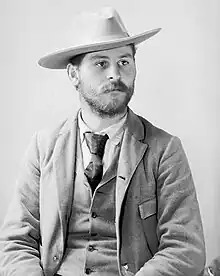
John Alvin Anderson (March 25, 1869 – June 26, 1948) was a Swedish-American photographer who spent most of his life in the United States.[1] He is known for photographing Sioux Indians at the Rosebud Indian Reservation in South Dakota from 1885 until 1930.[2] Many of his works are displayed at the Nebraska State Historical Society in Lincoln, Nebraska.[3]
Early life
Anderson was the sixth child born to Anders Salomon Gabrielsson and Anna-Beata Magnusdotter. The family farmed in present-day Vinberg-Ljungby, near Falkenberg, in Halland, Sweden. Gabrielsson spent time in the United States in 1869, earning money to send home, and in May of the following year, shortly after Anderson was born, the entire family emigrated to Pennsylvania. Magnusdotter died in 1876, and her widowed husband moved the family an area of Nebraska with a large Scandinavian immigrant population in 1883.[4][5]
Life and work
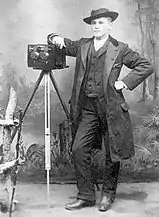
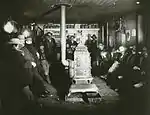

Anderson worked as a carpenter and spent some of his income on a Premo View camera, a high-quality brand at the time. His earliest photographs date back to about 1880. He assisted established photographer William Richard Cross (1839–1907) in taking photographs of soldiers at Fort Niobrara.
Anderson became close with members of the Sioux tribes during his time in Nebraska and nearby South Dakota,[6][7][8] and so in 1889, General George Crook asked him to work as an official photographer during negotiations between the State and the Native Americans. These talks resulted in the creation of the Rosebud Indian Reservation.[9] The following year, Anderson released his first book of photographs, Among the Sioux.[10]
Outside of his role as a photographer, Anderson worked as a mediator between the State and the Sioux. During his time, he amassed various Indian arts and crafts, including vases, weapons, and jewelry. During the 1890s, he became part owner and postalier of the trading station operated by Indian agent Charles Philander Jordan (1856–1924) at the Rosebud Reservation. Anderson documented and photographed the Sioux, including members of the most influential tribal families, over the 45-year period between 1885 and 1930.[11][12] Anderson's photographs included images of He Dog,[13] Fool Bull, Iron Shell, and Crow Dog.
A 1928 fire partially destroyed Anderson's photographs, but that year also saw the release of his second book of photographs, Sioux Memory Gems, on which he was helped by his wife, Myrtle. He and his wife moved to Rapid City in 1937, for several years, he was a curator of the Sioux Indian Museum. After Anderson's death, his wife sold his photographs to a private collector for one hundred dollars. They were eventually donated to the Nebraska State Historical Society. Some of Anderson's photographs are also on display at the Sioux Indian Museum in Rapid City.[14]
Personal life
He married Myrtle Miller (1870–1961) in 1895, and their son, Harold, was born in 1897.[15]
Bibliography
- Among the Sioux (1890)
- Sioux Memory Gems (1929)
Selected photographs
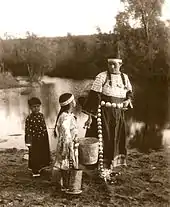 Sioux-women and children, 1900
Sioux-women and children, 1900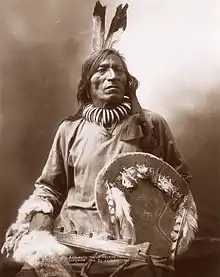 Fool Bull (1844–1909)
Fool Bull (1844–1909)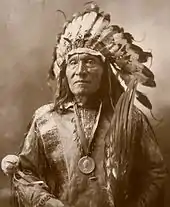 He Dog, Brulé (1836–1927)
He Dog, Brulé (1836–1927) Iron Shell (1816–1896)
Iron Shell (1816–1896)
References
- ↑ Claes Jacobson Rosebud Sioux: a Lakota people in transition (2004), page 15, C-H Jacobson produktion.
- ↑ "Photographers in The New York Public Library's Photography Collection". nypl.org. Archived from the original on October 6, 2014. Retrieved September 29, 2014.
- ↑ "Konstnärslexikon: A". lexikonettamanda.se. Retrieved September 29, 2014.
- ↑ "The Andersson family". karrdahl.se. Archived from the original on March 4, 2016. Retrieved September 29, 2014.
- ↑ "Västerns fotografer". bredbant.net. Archived from the original on November 4, 2013. Retrieved September 29, 2014.
- ↑ Hamilton and Hamilton, Sioux of the Rosebud, pp. 3–13. "John A. Anderson (born in Sweden, 1869, died 1948 in Atascadero, California)". UC Irvine School of Humanities. Archived from the original on July 9, 2018. Retrieved December 5, 2015.
{{cite web}}: CS1 maint: multiple names: authors list (link) CS1 maint: numeric names: authors list (link) - ↑ "Guide to the W.R. Cross Photograph Collection at the Leland D. Case Library of Western Historical Studies". Black Hills State University. Retrieved December 5, 2015.
- ↑ Thomas R Buecker. "Fort Niobrara, 1880–1906: Guardian of the Rosebud Sioux" (PDF). Nebraska History 65 (1984): 301–325. Archived from the original on May 22, 2013. Retrieved December 5, 2015.
{{cite web}}: CS1 maint: unfit URL (link) - ↑ "Fotopionjär bland indianerna". Släkthistoria. Retrieved September 29, 2014.
- ↑ "Västerns fotografer". bredbant.net. Archived from the original on November 4, 2013. Retrieved September 29, 2014.
- ↑ "John Alvin Anderson: Lexikonett amanda". Retrieved September 29, 2014.
- ↑ "Charles Philander Jordan, 1856–1924". Nebraska State Historical Society. February 13, 2009. Archived from the original on January 1, 2009. Retrieved December 5, 2015.
{{cite web}}: CS1 maint: unfit URL (link) - ↑ "Chief He Dog by J.A. Anderson, Platinum Print, Signed by Stan Klimek, Smithsonian". franklinbook.com. Retrieved September 29, 2014.
- ↑ "Västerns fotografer". Archived from the original on November 4, 2013. Retrieved September 29, 2014.
- ↑ Jacobson, Claes H. (April 2009). "John Anderson: A Swedish Immigrant and Pioneer Photographer among the Rosebud Sioux Indians". Swedish-American Historical Quarterly (v. 60, no.2, p. 59-71). Retrieved December 5, 2015.
External links
 Media related to John Alvin Anderson at Wikimedia Commons
Media related to John Alvin Anderson at Wikimedia Commons- John Alvin Anderson at Find a Grave